1. Introduction
 A few weeks ago, Sapphire organized a press conference at the Metropolitan Hotel in Athens. CDRinfo was there to get the latest news directly from the staff of this world-class manufacturer. During the conference, Sapphire held a lottery with prizes some of its products. One member from our team was lucky enough to win an AGP Sapphire X800 which as promised, we'll be reviewing here.
A few weeks ago, Sapphire organized a press conference at the Metropolitan Hotel in Athens. CDRinfo was there to get the latest news directly from the staff of this world-class manufacturer. During the conference, Sapphire held a lottery with prizes some of its products. One member from our team was lucky enough to win an AGP Sapphire X800 which as promised, we'll be reviewing here.
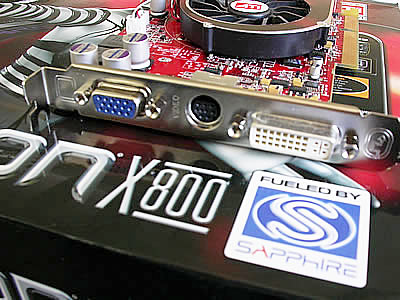
The X800 is ATi's answer to NVidia's very successful 6600GT. There are currently two versions of the X800, one with 128MB and one with 256MB. The card we'll be testing has 256 MB.
Being an X800, it promises a lot as it brings to mind the performance of the killer X800XT. However, this particular model has a price tag up floating around as much as US$219 (VAT excl) so we would expect average performance.
- Packaging/Bundle

The card ships in the impressive package you see in the picture above.
Inside, it we found a series of CD-ROMs with the following software:
- Prince of Persia : Sands of time
- Splinter Cell : Pandora Tomorrow
- Catalyst Drivers
- PowerDVD
- PowerDirector
- Redline overclocking software
Both games selected by Sapphire are great and if you haven't already had the chance to play them, you should do so as soon as you get your X800.
Apart from the software, a full set of accessories is also included with the card:
- VGA to DVI adaptor
- S-Video cable
- Composite cable
- VIVO cable
2. Features
| Main Features |
| GPU |
ATi Radeon X800 - R430 |
| Memory Brand/Model |
Samsung K4J55323QF-GC20 (2.0ns) |
| Memory Type |
256 MB 256-bit GDDR3 |
| Engine Clock Speed |
390MHz |
| Memory Clock Speed |
350MHz (700MHz effective) |
| Memory Bandwidth |
22.4 GB/sec |
| Pixel Pipelines |
12 |
| Vertex Pipelines |
6 |
| Fill rate |
4.68 Giga pixels /sec |
| DX Support |
9.0 |
| OpenGL Support |
1.5 |
| Output |
VGA / DVI-I / D-Sub |
| Bus |
AGP 4X/8X |
| Processing technology |
0.11 micron |
The X800 is based on the latest (but not greatest) processor from ATi, the R430. With 12 pixel pipelines as opposed to 16 on the X800XL and X800XT, the X800 is closer to the X800pro, yet far cheaper. The Vertex engines on the other hand are 6, in all X800 products. However, the clock frequencies for the X800 are lower than that of the PRO as you can see in the table below.
The 256MB GDDR3 and the 256-bit memory bandwidth both point to a high-end graphics card. The memory type used is also extremely good but really goes to waste as the memory clock is set at a much lower frequency than the memory can handle.
|
X800 |
X800 Pro |
X800 XL |
X800 XT |
| Core(MHz) |
390 |
475 |
400 |
540 |
| Memory(MHz) |
350(700) |
450(900) |
490(980) |
590(1180) |
| Pipelines |
12 |
12 |
16 |
16 |
| Fill Rate (Gpixels/s) |
4.68 |
5.7 |
6.4 |
8.6 |
| Memory Bandwidth(GB/s) |
22.4 |
28.8 |
31.4 |
37.8 |
| Aprox. Retail Price |
$250 |
$300 |
$350 |
$500 |
SMARTSHADER! HD
Full hardware acceleration of Microsoft® DirectX® 9.0 programmable vertex and pixel shaders in hardware
DirectX 9.0 Vertex Shaders
- Vertex programs up to 65,280 instructions with flow control
- Single cycle trigonometric operations (SIN & COS)
DirectX 9.0 Extended Pixel Shaders
- Up to 1,536 instructions and 16 textures per rendering pass
- 32 temporary and constant registers
- Facing register for two-sided lighting
- 128-bit, 64-bit & 32-bit per pixel floating point color formats
- Multiple Render Target (MRT) support
Complete feature set supported in OpenGL®
via extensions
SMOOTHVISION! HD
2x/4x/6x Anti-Aliasing modes Sparse multi-sample algorithm with gamma correction, programmable sample patterns, and centroid sampling Lossless Color compression (up to 6:1) at all resolutions, including widescreen HDTV resolutions, Temporal Anti-Aliasing 2x/4x/8x/16x Anisotropic Filtering modes
- Up to 128-tap texture filtering per AA sample
- Adaptive anisotropic filtering algorithm with bilinear (performance) and trilinear (quality) options
HYPER Z! HD
3-level Hierarchical Z-Buffer with Early Z Test
Lossless Z-Buffer Compression (up to 48:1)
Fast Z-Buffer Clear
Z cache optimized for real-time shadow rendering • Optimized for performance at high display resolutions, including widescreen HDTV resolutions
VIDEOSHADER! HD
Seamless integration of pixel shaders and video in real time
FULLSTREAM™ video de-blocking technology for Real, DivX, WMV9 and WMV10 formats
VIDEOSOAP™ noise removal filtering for captured video
MPEG1/2/4 decode and encode acceleration DXVA support Hardware Motion Compensation, iDCT, DCT and color space conversion
All-format DTV/HDTV decoding
Adaptive Per-Pixel De-Interlacing and Frame Rate Conversion (temporal filtering)
3. A closer look
The Sapphire X800 is built on the same fire red PCB we're used to seeing. However, one thing has definitely changed is the length of the board. The X800, just like the X800XL, is almost as long as the motherboard itself.
 |
| The front side of the card.(click for hi-res). |
The metal plate located on the rear of the card serves two purposes. One is to hold the X800's cooler in place and the other is to dissipate heat from the the memories.
 |
| The back side of the card (click for hi-res) |
Underneath the cooler and the metal plate, there is a set of 8 32MB GDD3 memory chips, resulting in the 256MB capacity.
The memory type used is the K4J55323QF-GC20 from Samsung. The speed of 2.0ns which translates to 500MHz, leaves much ground for further overclocking as the stock memory clock frequency only is set to 350MHz.
Removing the HSF from the card unveils the GPU core and the front set of memories.

On the heatsink, the small copper square is where it contacts the GPU while the two rectangular protrusions contact and hence cool, the front side memory modules.

The X800 chipset uncensored. There are two things worth noticing here. Check the following zoomed-in picture:

First of all, the label on the core reads "X800 PRO" while this is clearly an X800 vanilla product. Second, at the bottom of the picture you can clearly distinguish "PCI-EXPRESS", even though this is an AGP graphics card.
The fact is that this is the exact same chipset we saw on the X800XL card from Connect3D. Still, the X800XL featured 16 pixel-pipelines whilst this one just 12.
The two GPU's look identical so there's no way we can hardmod the X800 into an X800XL. The 4 missing pipelines seem to be laser-cut as none of the people that tried to flash the vanilla with an XL BIOS managed to unlock them.
The explanation for the PCI-Express logo found on the X800's core, lies beneath the pink covering on the chipset at the back of the card which you can see below:

That chipset is actually the famous RIALTO chipset ATi was preparing some time ago. It translates all PCI signals coming from the card into AGP signals so that the GPU can communicate with the AGP bus interface. This means that ATi no longer has to create two different versions for each of its processors.
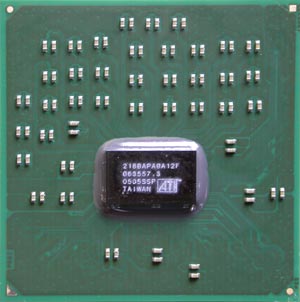 |
| Removing the cover, reveals the rest of circuitry on the RIALTO chipset |

The card's output, as in most cases, consists of one standard VGA for CRT monitors, one DVI-I for TFT monitors and a D-sub for VIVO use.
4. Test System
Processor: AMD 3800+
Case: Antec 1080AMG
Motherboard: Asus A8V Deluxe
Memory: 2x512MB OCZ PC-4200 Memory
Hard Disk Drive: WD800JD 80GB 7200RPM
CD-RW: LiteOn LTR-52246S
PowerSupply: Levicom 500Watt
Microsoft WindowsXP Pro SP2
DirectX v9.0c

Benchmarking Software
3DMark05,03,01
Codecreatures Benchmark Pro
AquaMark3 v3.0
ATiTool 0.0.23
Farcry v1.3
CounterStrike Source
Doom 3
Thief 3
Ground Control II
Colin McRae '05
5. 3DMark05
 With 3DMark05, Futuremark continues the tradition in its benchmarking software by providing a state-of-the-art Microsoft ® DirectX ® 9 3D performance benchmark.
With 3DMark05, Futuremark continues the tradition in its benchmarking software by providing a state-of-the-art Microsoft ® DirectX ® 9 3D performance benchmark.
3DMark05 is an all new 3DMark version making the most of Microsoft's DirectX
9. The previous version 3DMark03, did a nice introduction into this level
of technology. However
3DMark03 used DirectX 9 specific features in a limited manner, because fully
supporting hardware was rare at the time of its launch. In contrast, 3DMark05
requires DirectX 9 hardware with full support for at least Shader Model 2,
and takes shader usage to never before seen levels.
Just like its predecessors, 3DMark05's points system is set so that at the
moment of release, the high-end VGA cards available in stores can only score
around 5000 3DMarks, whereas the worst card that meets the program's requirements
yields a score of 1000.
Game Test 1 - Return to Proxycon
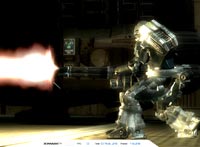 Being the sequel to the "Battle of Proxycon"
from 3DMark03, in "Return to Proxycon" we're once again set in space
and the battle continues as space pirates invade a cargo ship in order to
take control of its valuable cargo.
Being the sequel to the "Battle of Proxycon"
from 3DMark03, in "Return to Proxycon" we're once again set in space
and the battle continues as space pirates invade a cargo ship in order to
take control of its valuable cargo.
This test, tries to simulate a future first-person shooter game with all the high details that entails. The dynamic shadows, high-detailed environment and advanced lighting techniques ensure that under normal circumstances, no recent card can run it with decent frame rates.
Game Test 2 - Firefly Forest
 A forest gets filled with magic fireflies in the night. The moon is nearly full, illuminating the forest with a bluish faint light. The magic fireflies have flickering bright green lights that playfully move around the forest.
A forest gets filled with magic fireflies in the night. The moon is nearly full, illuminating the forest with a bluish faint light. The magic fireflies have flickering bright green lights that playfully move around the forest.
This scene is a nice example of a smaller scale outdoor scene with rich vegetation. Immediate visibility is not so far, and there is a skybox surrounding the whole scene.
A large number of trees with their branches swinging separately, and dense vegetation being dynamically distributed according to the camera movements, make this test the most demanding of the three.
Game Test 3 - Canyon Flight
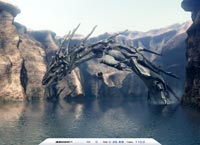 A Jules Verne type airship flies through a canyon guarded
by a dangerous sea monster. The airmen defend their ship using heavy cannons,
but these seem to have no effect on the huge sea monster. Finally the crew
manages a narrow escape using the "last resort" afterburners of
the airship.
A Jules Verne type airship flies through a canyon guarded
by a dangerous sea monster. The airmen defend their ship using heavy cannons,
but these seem to have no effect on the huge sea monster. Finally the crew
manages a narrow escape using the "last resort" afterburners of
the airship.
This scene is fairly complex with large areas of water
reflecting the high canyon walls. The water actually is one of the key points
of interest in this scene. The water not only does realistic looking reflections
and refractions, it has a depth fog, making the sea monster swimming under
the airship actually look deep down in the water. The air in this scene also
uses a volumetric fog, making distant cliffs of the canyon really look far
away.
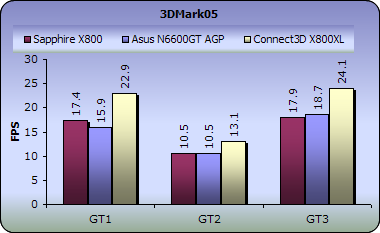
In 3DMark05's three game tests, two things become apparent. Firstly there's a long road for the X800 to walk in order to reach the XL's performance. Secondly, the 6600GT and X800 had pretty much the same performance.
Final Score
3DMarks on 3DMark05 are now calculated by the following formula:
(Game Test 1 * Game Test 2 * Game Test 3)^0.33 * 250
That's basically the geometric mean of the total frames in each
game multiplied by 250. This means that all game tests are now equal.

In the final 3DMark05 score, the Sapphire X800 barely managed to squeeze ahead of the 6600GT. The X800XL of course, got the highest score at 4830 3dmarks.
6. 3DMark03
 3D Mark is a widely used and accepted benchmark that stresses the DirectX performance of a VGA card. A very strong point of 3DMark is that it's VGA card measuring is does not require any CPU power. So the resulting fps are a good reference a VGA card's rendering performance. For testing the performance of each card we used the 4 game benchmarks 3DMark has.
3D Mark is a widely used and accepted benchmark that stresses the DirectX performance of a VGA card. A very strong point of 3DMark is that it's VGA card measuring is does not require any CPU power. So the resulting fps are a good reference a VGA card's rendering performance. For testing the performance of each card we used the 4 game benchmarks 3DMark has.
3Dmark03 also includes sound and CPU tests as well as some other feature tests.
- Game Test 1 - Wings of Fury (DX7)

This test is a combat flight simulator written for older hardware (DirectX 7). Particles are used a lot in this test - smoke and vapor trails, flak and gunfire, and explosions are produced using point sprites and quads.
- Game Test 2 - Battle of Proxycon (DX8)

This test is a simulation of first person shooter game types. 1.1 and 1.4 Vertex shaders are widely used since all character models are skinned using vertex shaders.This makes this test a good vertex shader comparison for VGA cards.
- Game Test 3 - Trolls' Lair (DX8)

This test should be the favorite of all RPG lovers. It is a cut scene of a female warrior facing two malicious trolls. Again the same vertex and pixel processing is used as in game test 2.
This test also uses post-processing effects, such as Depth of Field and Bloom effects which are widely used in today's game cut scene sequences.
- Game Test 4 - Mother Nature (DX9)

Mother nature represents the level of effects and realism that are possible using 2.0 vertex and pixel shaders, plus some other features that DirectX 9 offers.
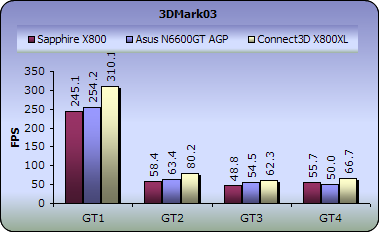
In 3DMark03, the 6600GT forges ahead of the X800 in the first three benchmarks which test DX7 and DX8 code. However, the X800 saved the best for the DX9-based GT4 test, where it yielded 5 fps more than the 6600GT.
- 3DMark Official score
If you test your machine with 3DMark, you can post the results at 3DMark's online result browser. For more information visit futuremark.com.
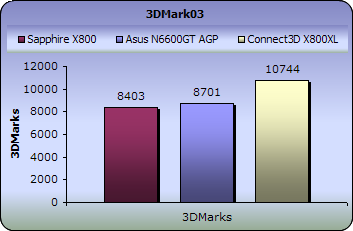
The scores in Futuremark's 3DMark03 show Connect3D's X800XL dominating over both the other cards. Second once more by a small margin is the 6600GT with the X800 just 300 3dmarks behind.
7. Codecreatures
 CodeCreatures is a synthetic 3D benchmark that is a good reference for VGA performance comparison. This is a high-end 3D benchmark that also requires DirectX 8 hardware, making a good tool for measuring the potential of DirectX 8 game performance.
CodeCreatures is a synthetic 3D benchmark that is a good reference for VGA performance comparison. This is a high-end 3D benchmark that also requires DirectX 8 hardware, making a good tool for measuring the potential of DirectX 8 game performance.
The Codecreatures benchmark is written with Microsoft's DirectX 8.1 API and incorporates the use of Vertex and PixelShaders popular on next generation 3D accelerators.

The benchmark plays a photo-realistic nature scene and calculates the performance of the graphics adapter by measuring the fps that it can display at 1024x768, 1280x1024 and 1600x1200 resolutions.

-Codecreatures number
The codecreatures number is the resulting score of the total
benchmarking process and is basically the geometric mean of the three frame
rates multiplied by 100.

In Codecreatures, it's the X800 that now generated better framerates than the Asus 6600GT. With an average of 2 more frames per second, its final codecreatures score is higher by 250 points.
8. Aquamark3 / 3DMark 2001
 Since the majority of today's applications and games are compatible with DirectX 9, the need of benchmark applications that use DX 9 has been brought up. The benchmark uses the 3D engine (Krass engine) of the Aquanox game.
Since the majority of today's applications and games are compatible with DirectX 9, the need of benchmark applications that use DX 9 has been brought up. The benchmark uses the 3D engine (Krass engine) of the Aquanox game.
Aquamark Triscore
The Aquamark Triscore comprises 3 values: the overall system performance, the performance of the graphics system and the CPU performance. Keep in mind that this is not the total result of the tests, but the result of the whole benchmark process including all 9 chapters.
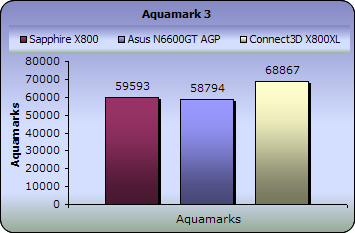
3DMark 2001
3DMark 2001 is the predecessor to 3DMark03. It's mainly a directx8.1 benchmark and the score depends a lot on the CPU power of your computer. However for reference use only we decided it'd be best to just leave it in our benchmark list so you can compare the next generation cards with the possibly outdated you have at home.

With such high scores in Aquamark3 and 3DMark2001, it's so hard to spot differences in the charts unless you take a look at the actual numbers and compare them. These two tests are very CPU dependant so have simply included left here for reference.
9. Half life 2
Half life 2 is no doubt the most anticipated pc game of all times. Gamers keeping the excellence of Half Life 1 in their mind as well as the remarkable E3 demo preview, have been anxiously waiting for the much delayed release of HL2.
 Characters - Advanced facial animation system delivers the most sophisticated in-game characters ever seen. With 40 distinct facial "muscles," human characters convey the full array of human emotion, and respond to the player with fluidity and intelligence.
Characters - Advanced facial animation system delivers the most sophisticated in-game characters ever seen. With 40 distinct facial "muscles," human characters convey the full array of human emotion, and respond to the player with fluidity and intelligence.
Physics - From pebbles to water to 2-ton trucks respond as expected, as they obey the laws of mass, friction, gravity, and buoyancy.
 Graphics
- Source's shader-based renderer, like the one used at Pixar to create movies
such as Toy Story® and Monster's, Inc.®, creates the most beautiful
and realistic environments ever seen in a video game.
Graphics
- Source's shader-based renderer, like the one used at Pixar to create movies
such as Toy Story® and Monster's, Inc.®, creates the most beautiful
and realistic environments ever seen in a video game.
AI - Neither friends nor enemies charge blindly into the fray. They can assess threats, navigate tricky terrain, and fashion weapons from whatever is at hand.
To measure performance we used the Video Stress Test(VST) that is available in the CounterStrike:Source beta available through Steam. We set all the details to the highest level and each time changed the resolution from 800x600 up to 1600x1200.
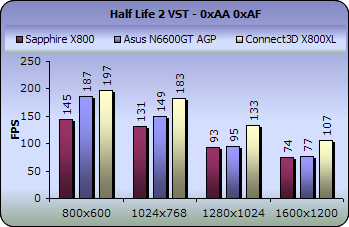
In the Half Life 2 Video Stress Test, the X800's framerate for 800x600 and 1024x768 is much lower than the 6600GT but as we move to higher resolutions, the gap vanishes. This is partly due to the X800's greater fill rate which is a crucial factor in high resolution performance.
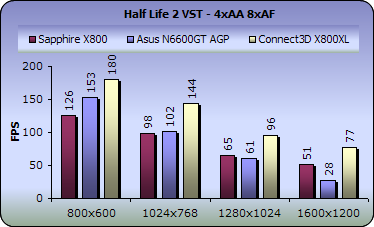
Enabling Anti-Aliasing and Anisotropic-Filtering, yields similar results at first, but this time the N6600GT is much more affected by the increasing resolution and drops down to half the X800's performance under 1600x1200.
10. Doom 3

A massive demonic invasion has overwhelmed the Union Aerospace Corporations? (UAC) Mars Research Facility leaving only chaos and horror in its wake. As one of the few survivors, you struggle with shock and fear as you fight your way to Hell and back, in an epic clash against pure evil.
Activision made it's miracle again with Doom 3 which is said to be the best-looking game ever, thanks to the brand-new OpenGL graphics engine used to generate its convincingly lifelike, densely atmospheric, and surprisingly expansive environments. If you are a fan of the previous Doom games then you will get many flashbacks with this revision, since you will find reimagined versions of almost every monster from both Doom and Doom II.

To measure performance on the game we used the timedemo demo1 command from the console (Alt+Ctrl+~).
Enabling the high quality setting and executing the timedemo demo1 command twice for each resolution, we witnessed the following:
First, without the Anti-Aliasing and Anisotropic Filtering settings
enabled, we got the following results:
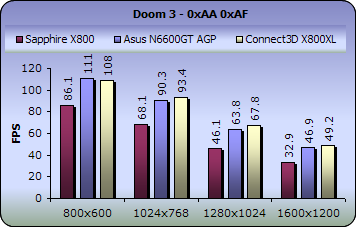
You can easily tell the N6600GT is an NVidia card just by looking at the chart above. Its performance easily exceeds that of the Sapphire X800 and climbs up to reach the X800XL. Once again, high resolution and Anti-Aliasing/Anisotropic Filtering is the only solution for the ATi cards.
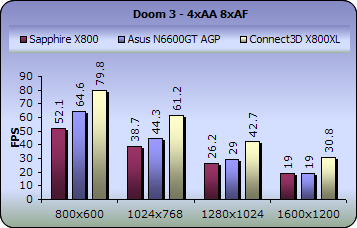
Now the 6600GT's performance has obviously dropped and it can no longer do as well as the X800XL. Moreover, the difference between it and the Sapphire X800 is slowly declining to zero as we move to the higher resolutions.
11. Far Cry

 You are Jack Carver running your own boat charter business in beautiful Micronesia. With a past best left behind you, you'll be focusing on your present assignment: escorting an ambitious journalist named Valerie Cortez to the Island of Cabatu. It seems like a piece of cake, but you'll soon learn: paradise can be hell.
You are Jack Carver running your own boat charter business in beautiful Micronesia. With a past best left behind you, you'll be focusing on your present assignment: escorting an ambitious journalist named Valerie Cortez to the Island of Cabatu. It seems like a piece of cake, but you'll soon learn: paradise can be hell.
Farcry is an awesome First Person Shooter (FPS) based on a last generation 3D engine named as CryEngine. Real-time editing, bump-mapping, static lights, network system, integrated physics system, shaders, shadows and a dynamic music system are just some of the state of-the-art features that the CryEngine offers.
A great advantage and strong point of the CryEngine is its physics system which supports character inverse kinematics, vehicles, rigid bodies, liquid, rag doll, cloth and body effects. All physics seem to be very realistic and you never get bored when facing enemies, since character models have multiple animations that blend in believable ways.
With an integrated shader system and a massive terrain which maximizes
the view distance to 2km, these features make Farcry a perfect action game and
also a referable benchmark to speak of.
- Benchmark Settings
For this game, we recorded a custom demo from the start of the Rebellion
stage. We chose an indoor scene in order to avoid getting the CPU bound effect. This will result in slightly higher results since it is also less
GPU intensive, but we can't afford being stuck at 40-50 fps because of our CPU.

The latest patch (1.3) was used for our tests which updates the
game's graphics engine to use the 3.0 Shader model. This option is only supported
for the 6800 series.

The resolutions we ran the demo under, are the following: 800x600,1024x768,
1280x1024 and 1600x1200.

In Far Cry, despite our expectations, the X800 still got the worst framerates trailing the N6600GT by 1-12fps.

The situation changes once again if we enable AA and AF. The X800 starts with an excellent framerate of 70fps at 1024x768 and falls to 32fps at the highest resolution.
12. Thief 3
 Instead
of Deus Ex from now on we'll be testing our cards using Thief 3. It's based
on the same engine but it's much less GPU intensive and playable by more VGA
cards than
Instead
of Deus Ex from now on we'll be testing our cards using Thief 3. It's based
on the same engine but it's much less GPU intensive and playable by more VGA
cards than  Deus.
Deus.
The game makes severe use of Pixel Shader 1.1 instructions, the bloom effect and stencil shadows to achieve a wonderful result in your screen.
In the game you play the part of Master Thief Garrett who is back to rule out any evil forces using his unique stealth abilities. Deadly Shadows shows what stealth gameplay is all about. This game really gives you the feel of sneaking around and holding your breath when stuck in a sticky situation.
Since there is no official benchmark for the game, we'll do our tests using
a GPU intensive scene from the tutorial-level which we believe that represents
the average fps you'll get when playing the game.
Thief 3 is a torture test for graphics cards. All lower class cards fail to provide stable performance in this benchmark when selecting full details from the settings menu.
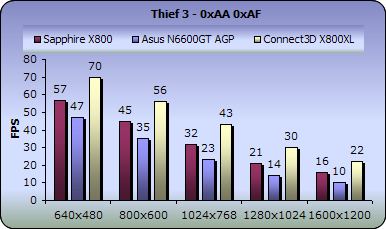
The X800 managed to produce 32fps under 1024x768, making the game enjoyable even with all details enabled. The N6600GT at the same resolution, could not handle it and fell to 23fps.
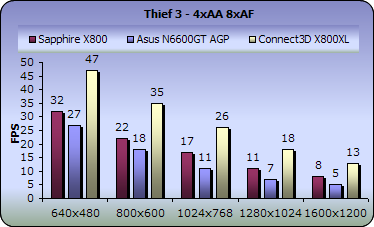
13. Colin McRae 05
 For all you racing fans out there, this test is for you and will represent the Racing game category in our benchmarks.
For all you racing fans out there, this test is for you and will represent the Racing game category in our benchmarks.
From the graphics point of view the first thing you'll
notice in the game is the excellent amount detail of your racing car. High
resolution textures on the car and lighting make it quite impressive. All
the eye candy such as the sun reflection in the virtual camera are still the
same as the older CM versions but motion blur has been added when your card
hits something hard which will happen most often if you're new to the racing
simulation world.
To measure performance on the game we used fraps to get the average fps of the whole 8th stage of UK which is actually the only stage you get to play on the demo.

Colin McRae 2005 tends to be much kinder with ATi cards. The Sapphire X800 starts off with a 13fps lead which varies around 20fps as we increase the resolution further.

Enabling 4x Anti-Aliasing and 8x Anisotropic Filtering to increase image quality, only the X800XL can come up with great framerates under all resolutions. However, both the X800 and 6600GT didn't do so badly and the game is still enjoyable at 1280x1024.

14. Ground Control II
 Ground
Control 2 is an action-oriented game of tactics and warfare. As Captain Jacob
Angelus of the Northern Star Alliance, you will command squads of infantry,
artillery, and air power against the might of the Empire of Terra. Base building
and resource-collecting are replaced with unit control and combat tactics where
your knowledge of the battlefield maneuvers will make the difference in your
fight against a ruthless enemy. Position your troops on hilltops for better
aim or inside buildings and forests for protection as you'll need to use every
inch of terrain to your advantage.
Ground
Control 2 is an action-oriented game of tactics and warfare. As Captain Jacob
Angelus of the Northern Star Alliance, you will command squads of infantry,
artillery, and air power against the might of the Empire of Terra. Base building
and resource-collecting are replaced with unit control and combat tactics where
your knowledge of the battlefield maneuvers will make the difference in your
fight against a ruthless enemy. Position your troops on hilltops for better
aim or inside buildings and forests for protection as you'll need to use every
inch of terrain to your advantage.
For our benchmarks, we used the highest possible settings on the first mission
of the single player game and moved around the camera to get an average frame
rate using fraps.

Ground Control II offers really impressive graphics without requiring much GPU power. Click on the picture above to view a screenshot from the game. Check out these excellent water effects!

All three cards did well in this test. The framerate is above 40 for all cards which creates an excellent environment to play the game.

Setting AA to 4x and AF to 8x, it's the X800's turn to unexplainably drop framerates, losing the advantage we saw gain in the first chart.
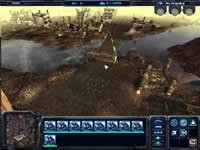
15. Overclocking
No matter your graphics card, there comes a time in your computer's life when it can no longer cope with the latest technology the ever so popular games use. This is one of the main reasons for overclocking your graphics card. Gamers are always looking forward for a little extra boost in terms of framerate. Even though most of the times the boost is far from noticeable, overclocking remains the last resort when you can't afford to buy a brand new VGA card.
 |
Increasing the memory clock too much,
produces the so-called "artifacts". |
The stock clocks are set to 390MHz and 350MHz as you can see in the ATiTool screenshot below.
 |
The factory frequencies for the Sapphire X800. |
Using AtiTool once again, step by step we increased the memory and core frequencies until we found the maximum stable settings for each clock.
Through trial and error, the final settings we arrived at are 440MHz and 560MHz. The core got overclocked by 50MHz while the memory clock frequency was increased by an amazing 210MHz!! The memory parts chosen by Sapphire proved to be an excellent choice for overclocking.
Let's see the performance boost we got after overclocking:
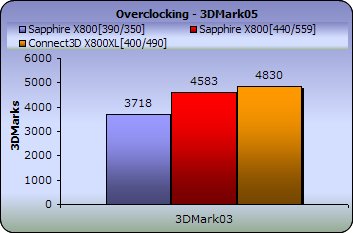
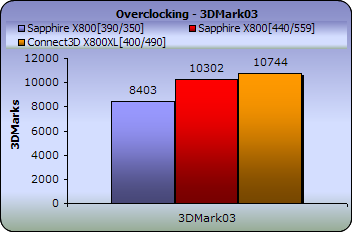
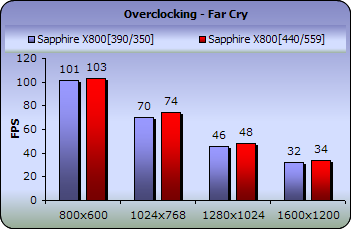

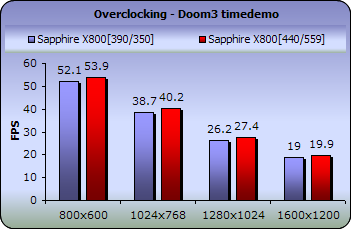
The overclocked Sapphire X800 is nothing like the stock clocked X800. In both 3DMark05 and 3DMark03, we got a boost of around 22%(!!!), almost reaching the X800XL's performance. In games however, this difference will not be noticed, as the 4 disabled pixel pipelines greatly affect performance for the settings we chose to use (4xAA and 8xAF).
In the future, we will update this page with the results for normal image quality.
16. Conclusion
The big question for the Sapphire X800 is if the card is any better than the 6600GT. Generally, both seem to be offering approximately the same performance and each benchmark, synthetic or not, indicated a different card as the better. The X800, as with it's other relatives from the X800 family, had an advantage in performance with Anti-Aliasing and Anisotropic Filtering enabled, while the 6600GT dominated in Doom3 performance. There might not be a definite answer to the question, however the X800 still holds an ace up its sleeve and that is, its overclocking potential.
Overclocking the X800 boosts the card's performance nearer towards higher class cards. The increase in 3DMark05 and 3DMark03 is absolutely breath-taking, but still these two are just synthetic benchmarks and games didn't show similar gains in performance. One thing is certain, if someone finds a way to enable the missing pipelines (that's if they are not laser cut), this card can transform even further into a high end graphics card.
The Sapphire X800 package includes a full list of software, games and accessories. The games bundle with Prince of Persia: Sands of time and Splinter Cell : Pandora Tomorrow, which although a little outdated (the sequels to these games have already been released) are still an excellent opportunity to test your new graphics card's capabilities in action.
The Sapphire X800 ships for US$219 (VAT excl), a little more than a regular 6600GT but that's simply because it features 256MB instead of 128MB memory. Both cards are definitely worth the cost and justify it with an excellent price/performance ratio.
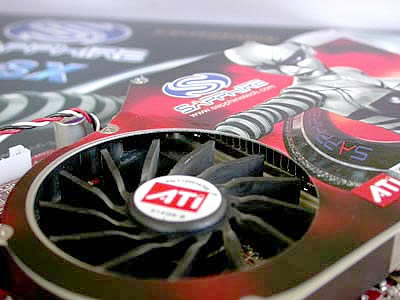
Pros:
- Excellent overclocker
- Excellent price/performance
Cons:
- Bundled games are a little outdated

| Performance: |
|
| Overclocking: |
|
| Bundle: |
|
| Value for money: |
|